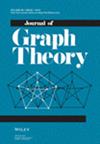在两个连续偶数长度的周期上
IF 1
3区 数学
Q2 MATHEMATICS
引用次数: 0
摘要
邦迪和文斯证明了每个最小度数至少为 3 的图都包含两个长度相差 1 或 2 的循环。我们证明了以下平均度对应关系:除非 4|(n-1)$4|(n-1)$且 G$G$ 的每个块都是一个小群 K5${K}_{5}$,否则每个至少有 52(n-1)$\frac{5}{2}(n-1)$ 边的 n$n$顶点图 G$G$ 都包含两个连续偶数长度的循环。我们的证明主要基于结构分析,其中一个关键步骤可能会引起独立的兴趣,它表明对于每一个至少有六个顶点的三连图,同样的结论都成立。这解决了 Verstraëte 猜想的一个特例。这个定量约束非常严密,而且还提供了长度为 2 modulo 4 的循环的最佳极值数。本文章由计算机程序翻译,如有差异,请以英文原文为准。
On two cycles of consecutive even lengths
Bondy and Vince showed that every graph with minimum degree at least three contains two cycles of lengths differing by one or two. We prove the following average degree counterpart that every -vertex graph with at least edges, unless and every block of is a clique , contains two cycles of consecutive even lengths. Our proof is mainly based on structural analysis, and a crucial step which may be of independent interest shows that the same conclusion holds for every 3-connected graph with at least six vertices. This solves a special case of a conjecture of Verstraëte. The quantitative bound is tight and also provides the optimal extremal number for cycles of length two modulo four.
求助全文
通过发布文献求助,成功后即可免费获取论文全文。
去求助
来源期刊

Journal of Graph Theory
数学-数学
CiteScore
1.60
自引率
22.20%
发文量
130
审稿时长
6-12 weeks
期刊介绍:
The Journal of Graph Theory is devoted to a variety of topics in graph theory, such as structural results about graphs, graph algorithms with theoretical emphasis, and discrete optimization on graphs. The scope of the journal also includes related areas in combinatorics and the interaction of graph theory with other mathematical sciences.
A subscription to the Journal of Graph Theory includes a subscription to the Journal of Combinatorial Designs .
 求助内容:
求助内容: 应助结果提醒方式:
应助结果提醒方式:


